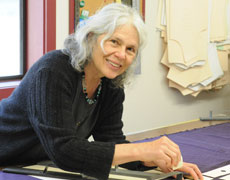Madeleine Vionnet: timeless classic lines
Posted by Rose on 21st Jul 2016
Long before women’s natural clothing was even a concept, this French designer upended fashion with her celebration of the natural human form.
Madeleine Vionnet: If the name doesn’t ring a bell, you’re not alone. Though less well known, her work has influenced designers such as John Galliano, Issey Miyake, Azzadine Alaia, among others.
And as an advocate for sustainable clothing, I find her story both inspiring and instructive.
A reading of her biography reveals a woman who remained true to her own vision. Born in Loiret, France in 1876, Madeleine Vionnet was married at 18, but after the loss of her child, she left her husband and France for England where she worked for a time as a laundress. She later worked as a fitter for a notable London gown maker.
Returning to France, at first she worked as a sample maker in the fashion house Callot Soeurs. After threatening to quit after a disagreement with a manager there, one of the Callot sisters convinced her to stay by offering her a promotion. Henceforth she would work with the eldest of the Callot sisters, Marie Callot Gerber, draping live models.
Vionnet began developing the bias-cut designs that would dominate the haute couture scene in the 1930s. In time, she’d become known as the “Queen of the Bias Cuts.” Her diagonal cuts were a breakthrough, freeing women everywhere from the tyranny of their corsets. Her appreciation of the beauty of the natural female form revolutionized modern clothing. Remembering her time at Callot Soeurs, Vionnet paid tribute to her former employer. “Without the example of the Callot Soeurs, I would have continued to make Fords. It is because of them that I have been able to make Rolls Royces."
By the 1920s her own enterprise had grown so vast she employed more than 1,000 people. Recalling her own apprenticeship perched on stools, her back aching and eyes burning in the dim light, Madame Vionnet saw that her workers enjoyed good working conditions. She provided health and dental care in on-site clinics and maternity leave. Yet oddly, workers in her 26 ateliers rarely saw the boss. She preferred working quietly in her study.
Women still seek fashions that celebrate the human body and allow free-ranging motion. That was at the heart of my idea for Sympatico too: unfussy elegance that’s easy to wear. I aim to infuse all my tops, skirts, and pants with those values. And I have Madame Vionnet to thank for lighting the way.
Share:









